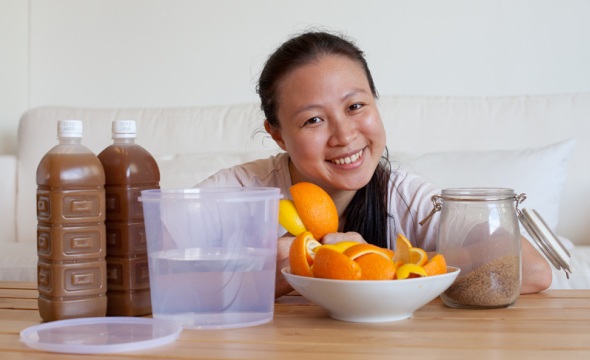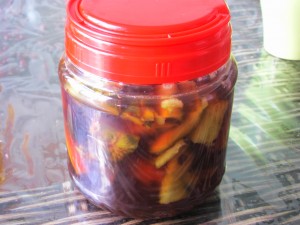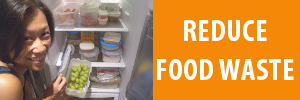Make Garbage Enzyme
By Save Food Cut Waste
Ler Lee Cheng runs thediysecrets, where she blogs about her discovery on natural living and sells green products such as soap nuts online. She started making garbage enzyme since year 2009 and shares that:
I still remember I was curious and excited at the same time when my aunty and cousin shared with me that it is possible to make my own household cleanser. I wanted to avoid using the chemically formulated detergents and powder and replace them with all natural cleanser. I want to live more naturally.
Lee Cheng uses the fruit leftovers from home, as she loves to eat fruits and drink fruit juice, and thus her fruit waste is mainly peels and pulps. To make garbage enzyme, she adds leftover fruits and peels to black sugar and water, and lets it ferment for 3 months.
The result is a homemade vinegar cleanser from her fruit waste. Garbage enzyme has a pungent vinegary smell, but the smell varies and it can smell really nice depending on the fruit waste that goes into the fermentation. Sometimes it could be citrus and sourish, and sometimes bitter. There’s no need to worry about the smell as it will dissipate after a while.
Lee Cheng loves to use the garbage enzyme to mop the floor, wash the sinks and toilets, as it removes dirt and grease really well. She recalls how pleasantly surprised she was when her dirty sink with stains turned out sparkling clean after using garbage enzyme.
Make garbage enzyme from your fruit and vegetable scraps, and use it for cleaning purposes.
How to Make Garbage Enzyme
Garbage Enzyme (not really an enzyme but a colloquial term) is actually vinegar or acetic acid derived from fermenting uncooked fruit and vegetable scraps, brown sugar and water. The vinegar with its acidic properties can be used as a non-toxic cleaner.
According to Eco Walk the Talk, here’s how to make garbage enzyme:
Supplies needed
- Molasses, jaggery or brown sugar
- Fresh vegetable and/or fruit peels ( dregs, peels and cuttings which are not cooked)
- Air-tight plastic container
- Measuring cup
Method
1. In an airtight plastic container, measure and add 1 part molasses + 3 parts veggie/fruit peels + 10 parts water.
Example by weight: Weight 100g molasses or brown sugar + 300 g of veggie/fruit peel + 1000g of water
Use any multiples thereof, maintaining the same ratio.
2. Give the mixture a good shake, and screw on the lid tightly.
The whole process takes less than 5 minutes to make once you’re all set up with the ingredients and container, and the fermentation takes a minimum of 3 months, so it’s best to stagger the enzyme making in batches with labels on the container indicating the date they are made. This will ensure a regular supply later on.
Please note: You’d need to keep the container airtight. However you must open the lid once a week or once every few days to let out the gases, otherwise they may build up to explode in the container.
3. After 3 months, you can filter the residue to get a clear, dark brown liquid that has a fresh, sour smell like vinegar.
You can use the garbage enzyme to clean your toilet bowl, or dilute it with water to clean your floor.
Start today to make garbage enzyme from your fruit and vegetable scraps, and use it for cleaning purposes.
Images credit: Ler Lee Cheng – Garbage Enzyme, Ler Lee Cheng; Garbage Enzyme in Container, Eco Walk the Talk
Source credit: Eco Walk the Talk
Interview credit: Ler Lee Cheng











This is great. Ihave made a couple of batches and was using it as fertiliser for my vegetables garden. Wonder if I can use it to wash my dishes.
This is an awesome website about Garbage Enzyme!!! :)
Can we collect the food waste over a period of time?
if yes, how do we store the food waste?
@Leena I keep my scraps in the freezer.
How do I know if it is going well? I used molasses so they have a dark tint from the start, after the first week I noticed a thin layer of bubbles, not quite foam. From week 3 onwards, no more bubbles! Is the fermentation on track??
Can the residue after straining the enzymes be used for making compost by mixing Browns ( carbon)
This is a good website and good work. I am from India and looking forward to start innovative techniques and methods to reduce kitchen waste and use the waste to make produce for animal food products etc.
dear cheng. i want to know if we can use the garbage enzymes in water for drinking purpose and will it remove all the chemical pollutants present in water. in case if we can use it in water for drinking purposes then what fruits, flowers and vegetable waste is to be used and i do not know this fact so kindly let me know on my email.
my email: sunildollard@gmail.com.
reply back on my email.
regards sunil
Can the eco enzyme repel dogs? Many ppl walk their dogs and let them pee outside my house, next to my plants. I need to find a way to discourage the dogs from stopping and peeing. The dog walkers don’t care.
hey… can i use fresh fruit?